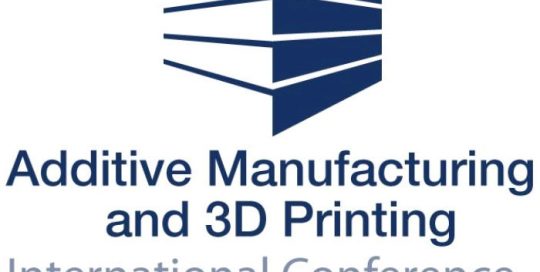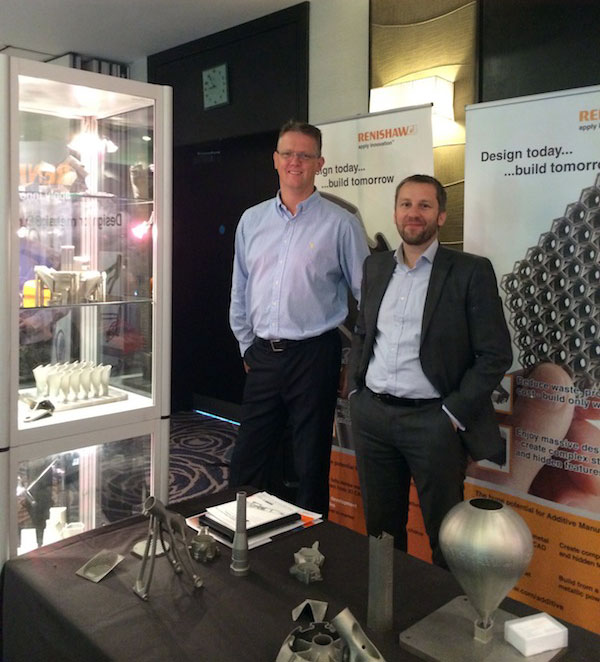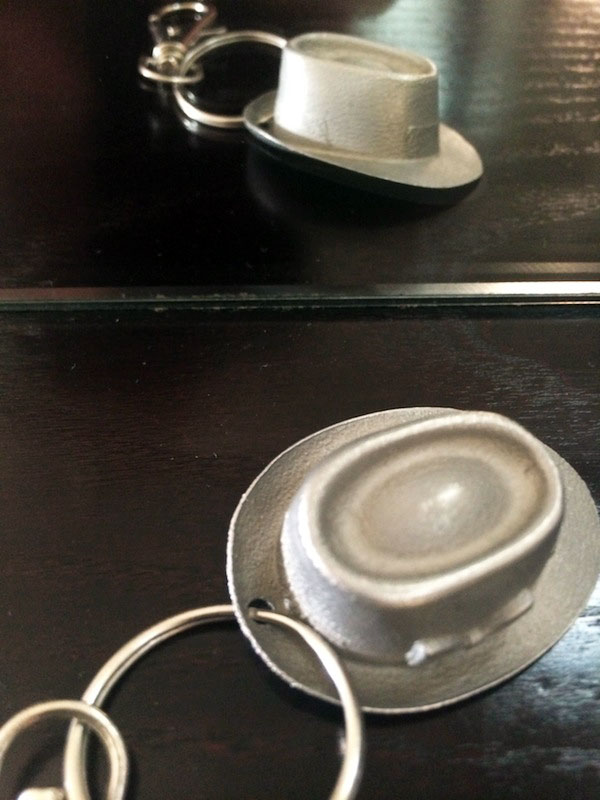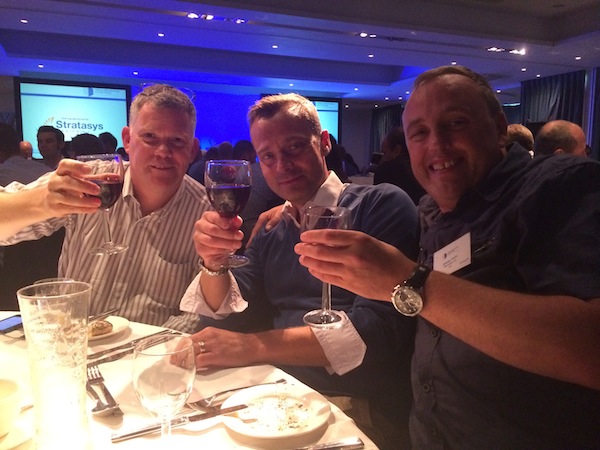My annual sojourn to Nottingham was this past week, to attend the International Conference on Additive Manufacturing (AM) and 3D Printing (3DP), hosted by the Additive Manufacturing & 3D Printing Research Group at Nottingham University and Econolyst Limited.
This year’s event, which, as I mentioned in my preview, is the ninth edition of the conference in its current form using the AM / 3DP vernacular. Talking of which, the vernacular is raising its ugly head again and is causing, at times, quite lengthy arguments. I was party to a few of them over the last few days. Probably best that I don’t lengthen this review with commentary on this issue, so if you want my further thoughts, go here.
This ninth edition event was an extended affair, with an extra day before the two-day conference offering a 3D Printing / Additive Manufacturing Masterclass co-presented by Professor Richard Hague who heads up the Nottingham University Group, Dr Chris Tuck who works with Richard and Phil Reeves of 3D Printing consultancy Econolyst. In his introduction to the session, Richard lit the touch paper commenting that the Nottingham standpoint is that 3DP and AM ARE different — despite the vernacular usage. He also highlighted how in the last couple of years they have become skeptics rather than evangelists — I can sympathise with that actually — the inflated expectations of people new to the technology demand it to a certain extent.

The masterclass gave attendees a good grounding for the following two-days, and it covered, at length, the reality of where the 3D printing industry is at. There was a nice nod to Adrian Bowyer, who, before his retirement was a fellow academic at Bath Univeristy and the much vaunted founder of RepRap. Indeed, Richard credits RepRap for the groundswell of enthusiasm around consumer 3D printing over the last five years. Subsequently, Richard covered the design issues around the 3D printing ecosystem, while Chris gave an overview of the different 3DP / AM processes.
On the afternoon of the same day, the delegates swelled to attend a session that provided an overview of Research Activities in UK Universities. It was fascinating to get a glimpse of some of the developments that are happening, but generally speaking, it was just a glimpse, quite a few of the presentations were rather woolly in their content, and I had it on good authority that this was intentional! The one stand out exception was Prof Akexander Pasko from Bournemouth University who, along with his team, is working with the NCCA (National Centre for Computer Animation). This was confirmed to me by Chris Sutcliffe, who was sat next to me, who leaned over and whispered “these guys are really good at this, best in the world.” However the really exciting thing I heard was about a project that Professor Pasko is working on with commercial partners that involves 3D modelling and 3D printing activities to help disabled children. More on this to follow soon.
The two-day conference proper got underway on Tuesday morning. Delegate numbers were at an all time high, with Phil telling me that if it grows at the same rate next year, re-location will have to be considered to accommodate the growth of delegates and exhibitors. It is not too surprising to hear this news, this conference has set itself apart on the 3D printing event calendar with a rich (eclectic!?) blend of research developments pointing to the future and a healthy dose of industrial reality now. There are no consumers in sight, and very few “makers.” This year, there were noticeably more women, too. And I wasn’t the only one that picked up on it either.
There wasn’t a single keynote presentation either, which was refreshing. All the speakers were on a level playing field.
Day one started with an insightful presentation from Frank Piller from RWTH Aachen University in Germany. According to Prof Hague, who introduced him, he is “a world god on mass customization.” Indeed Frank went on to highlight a
‘Systematic Business Model Innovation for the Maker Economy’ discussing the economic challenges for opportunities of additive manufacturing. Citing companies such as Apple, Dell and Pfizer he suggested that despite resistance in the beginning, business model innovators always outperform traditional innovators over time. For 3D printing, the exciting innovation is coming from the “User Innovator” who, more often is becoming the “User Manufacturer.” Interestingly though, Frank said: “I don’t see the killer application [of 3D printing] yet.”
Simin Zhou’s presentation, which rounded up the first session, did a good job of grounding me — and I would imagine — the entire delegation. She works for global company UL, and their mission, for the last 120 years, has been “making a safer world.” So within that remit and analyzing the opportunities of AM and 3D printing the issue of material qualification stood out head and shoulders above the other issues and challenges she raised. Safety is paramount, and making safe products with AM is not an easy task! Traditionally there is an emphasis on safety and qualification, as highlighted by Kirsten Borchers of Fraunhofer in her presentation later in the day. But also and often overlooked it is necessary for critical AND traditional products — Simin chose a washing machine as an example of the latter illustrating that IF the materials can’t be tested, traced and qualified the safety implications could be dire for the consumer and for the manufacturer. Control does have to be maintained – despite the excitement about localization and user manufacture.

I was delighted to see William Hoyle on the programme, his small charity – TechforTrade – is centred around using 3D printing as a development tool to alleviate poverty citing how 3D printing removes costs of production and waste, requires minimal inventory as products can be made on demand. Furthermore, for small traders it enables improved working capital management.
Of course, it is not all plain sailing and there are technology obstacles and logistical barriers to overcome, including affordability (relatively speaking), flexibility when it comes to repairs, simplicity and skills within remote communities, and scalability.
However, what TechforTrade is doing, and continues to do it prove that it can work – it is working! Willaim highlighted a number of projects in different regions of the world — Mumbai, Togo, Ghana, Haiti and Guatamala for instance, where communities are being supported to improve their circumstances, enabled by 3D printing. Thus the focus is not on the technology but on the benefits it can bring.
One of the biggest hurdles though, is access to materials due to their cost and distribution.
Rethinking how things work in this regard is what initiated the Ethical Waste Foundation. What if you could link waste pickers (who earn 15 cents per day in India) with a local market for filament. Thus the Ethical Filament Foundation is looking at how to invest in the future of socially sound 3D materials sourcing — with standards around quality, tech durability and ethics. The charity is working with Josh Pearce on testing, too and partner company Protoprint, which is the first company to produce Ethical Filament in Pune. William revealed the progress they are making and said that August will see them launch the first filament in the region.
The path has been a winding one and they have learned much from the experiences in Pune and are now looking to replicate the model elsewhere.
I, for one, will be cheering them every step of the way, and highlighting it wherever possible. William is a shining beacon of doing and not just talking about making a difference!
And then we got the spirited and energetic Tim Minshall up on stage — from the Institute of Manufacturing at the University of Cambridge. Tim opened with his raison d’etre — “We’re trying to get beyond the nonsense!”
Indeed.
Pointing to, and I quote, “a lack of joined up-ed-ness,” Tim and a team at Cambridge are undertaking a programme of research that maps the emergence of AM and 3D printing, in a bid to find the best route(s) forward. I don’t think I was the only one that was hoping for some answers from this presentation, but, in fact, what we got, was more questions ….. as the research aims to structure the big issues — how the technology will evolve and garner the investment they need while dealing with standards, supply chains and IP issues.
The first year of the BitByBit project has seen them cover suppliers of equipment and materials, look at the background and evolution from rapid prototyping in the late 80’s and early 90’s to map common and different strategies and studying the ongoing adoption of AM in various industries. Thus research questions have emerged and this research is intended to provide a technique for joining up the disconnected conversation.
With another 2.5 years to run on the project, the team is looking for participation and more conversations to fulfil its objectives of defingin how digital fabrication will affect the manufacturing landscape, what impacts it will have on manufacturing in the UK, and how can UK firms can become global leaders in this new age of digital manufacturing.
The presentation by Dominik Rietzel of BMW reiterated that this industrial user of 3D printing technologies is one with great longevity, they highlighted the company’s latest case study which we covered on 3DPI last week, but I think what stood out for me was the emphasis on education — and it is not just the responsibility of the education systems around the world — although it help, a lot. Dominik also stressed the importance of training young people through apprenticeships with these technologies — and pointed to the amazing motivation it can instill on the factory floor.
Brilliant.
Kate Black is a Chemist at the University of Liverpool. Her research is, essentially, into conductive inks for additive manufacturing. Kate is researching the sinter-free deposition of metal inks – nano particle inks and metal organic decomposition inks specifically, that can produce a wide range of functional materials. This work comes under the heading Reactive Organo-Metallic (ROM) inks. This is one very clever woman, and much of what she said went right over my head, and left me thinking she was way too clever for me to have an intelligent conversation with her. I couldn’t have been more wrong — and, with her colleagues being some of the old guard – Chris Sutcliffe, Matt Murphy et al, I shouldn’t have been so surprised to find she was delightful company, very down to earth, and happy to work on an accessible article about what she is doing and where it is going. And the woman can sing — and did! I have video to prove it.
I’ll mention the 7-1 score line, but only because it there were so many happy Germans around that evening. For the most part the evening was non-football related, fun and in delightful company, not least with Kevin (voxeljet), Lars (Arcam) and Jez (Renishaw).
Day two of the conference dawned sunny and warm and got underway with the first presentation of the day given by Maarten van Lierop of multi-national company Philips. He started with a question — Why is AM interesting to Philips? Well, it seems there are many reasons and this is why no title or abstract had been provided ahead of the conference — because it is “bits and pieces” of what we’re doing with AM. In a company as big as this, with 120k employees globally, it is not that much of a surprise, I guess. Maarten echoed some previous speakers, talking about the social and environmental impact of AM and highlighting the safety aspects — not for the first or last time. And, as with all the big companies presenting they are moving from the traditional application of using the tech “to do things faster,” ie prototyping and looking to apply it to manufacturing. Lighting, and in particular smart lighting, has huge potential to benefit from AM tech due to the low volumes involved. In this regard Philips has established new business models — From Pocket to Portal —to engage customers directly online.
Next up was a nicely posed antithesis to the previous presentation, from Neil Burns of Croft AM, which is a small company based in the North of England that manufacture filters. After a great deal of research, Croft invested in a metal AM machine — a Realizer 250 — which Neil described as a bold but productive move. The company set out to work with the machine from scratch – experimenting with variables, lots of tweaking etc and it has resulted in innovation and the ability to change filter designs that resulted in wholly new — and better — filtration products and an improved overall process.

With the next presentation the delegation was herded back to the huge multi-national perspective, with a talk by Pierluigi Tozzi of GE Oil And Gas. This involved some very specific content about heat treatment optimization. This particular division of GE, according to Peirluigi, has been investigating the tech since 2010 with a dedicated AM lab in Florence working with an EOS M280 platform and metals. Pushing the boundaries of tech the lab is always looking for new materials to meet the needs of their customers.
Italy was also the home of the next presenter — Fabio Ciciani of Exnovo. This presentation continued the theme of new business models, which definitely emerged as a trend over the two days. Exnovo is a design companyand highlighted some of their work with 3D printing in seeking a new aesthetic and connecting new tech with warmth. One of the company’s most successful products — Ophelia — has been taken up by stores in NYC, Singapore and Milan. While the aesthetics are a vital component of the design process, Fabio also emphasized that this was never at the cost of validation of the products — always carried out according to quality and safety standards. Another trending theme.
I’ll confess that I wondered how engaging a presentation titled “Design and Deterministic Fabrication of Li-ion Microbatteries” could be ahead of time. But Shen Dillon, of the University of Illinois did a good job of holding my attention when talking about his research, in collaboration with Jennifer A Lewis at Harvard. The main motivator for the research is the broad challenge of making autonomous devices that were at the micro / nano scale to power MEMS/NEMS., Shen told us. He also highlighted many of the challenges involved before getting to his main question: Why AM for micro batteries? Well, kinetics is sensitive to the micro structure – there needs to be control of the geometry, and, of course, 3D printing is the only manufacturing process that allows for that.
Having looked at a variety of 3D printing processes, the current focus is on Direct Write processes that permit experimentation with power and energy densities, as well as critical design parameters that also involve the packaging of the battery. The thing is, what occurred to me during this presentation is that with personal electronics being such a huge global industry, developments in this area will have an impact on all of us — for many of us it will just be additional convenience, which we will likely take for granted, but for others it can be a life or death difference, particularly for people in remote locations with limited electrical supplies.
Adam Clare is a Scouser at the University of Nottingham, working on “Proteus Powders – A Shape Shifting Pallet for AM.” Sounds posh, but what Adam was talking about, on behalf of a wider research team of which he is part, is improving materials and colour resolution, in particular with the SLM additive manufacturing process. He referenced the CMYK colour palette of 2D printing (or, as he suggested, if you come from Liverpool: Blue, red, yellow and black) and said that traditional printing has something to teach us about good resolution.
The central premise of this research is that the materials for SLM are expensive to achieve, involving a great deal of time and money, not to mention the environmental implications of processing the materials, particularly when you consider that the materials are purified and then mixed to make an alloy. What if you could create the alloy in process? The idea being to create complex materials during manufacturing. They have had mixed results, obviously challenges have presented themselves, but notable success has been achieved with a new technique – currently going through commercialization – to develop new powders – titanium satellited with ceramic boron carbide. And now, further, initial research is being taken into an Aluminium alloy – with zinc and copper. Early results are encouraging, says Adam, who believes that value added manufacturing will be possible.
For me this was a highlight, it shows how academic research is benefitting industrial progess. I know this can be a contentious issue for many, but it does and can work — we just need more of it.
The next two presenters did their best to make the issue of IP (as associated with AM and 3D printing) as interesting as possible. Indeed, Nicola Searle, from the UK’s Intellectual Property Office in Wales, vehemently disagreed with the view that this is a dry subject. I have to say, I’m one of the people she is vehemently disagreeing with. Despite her informed overview of the different levels of IP, the fuzziness that surrounds this issue, IMHO, is just so overwhelming and never seems to offer any answers — just lots and lots of questions. Questions that do need addressed, but personally I find it difficult address them with any sort of enthusiasm. Both Nicola and Dinusha Mendis, an IP lawyer, who followed Nicola on stage, were at pains to make the subject interesting. However, they both kind of proved my point and could offer no definitive answers on what’s happening in this area because, right now, nobody knows, not even them, who have more insight than most. Ultimately, what I took from these presentations is that cases that arise from infringed IP can only be settled on a case-by-case basis. The situation is evolving, and will continue to do so, but ultimately no one knows how it will play out, and even educated guesses pose more questions than answers.

And with that, the event closed. One noticeable omission during the two days was the them of standards, this was possibly because the ISO / ASTM meetings were following on from the main event with two further days. Carl Dekker of Met-L-Flo was one of the chief protagonists and he will hopefully be doing a round-up of the main points from those two days for 3DPI. One thing to note though, on a positive note, is that there is much more of a cross over between these two bodies, which has to be a good thing, it needs to be global (not Euro / US).
And so it just remains for me to thank the organizers for another inspiring event — with a big shout out for Donna Cope, without whom it would run nowhere near as smoothly as it does.



